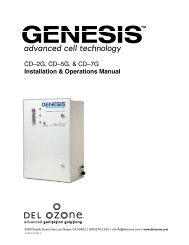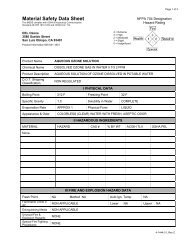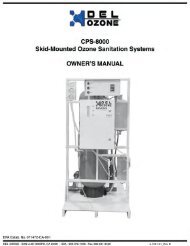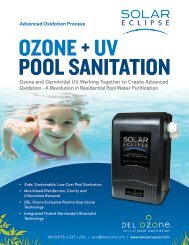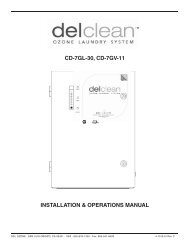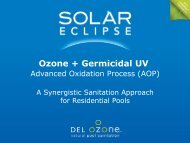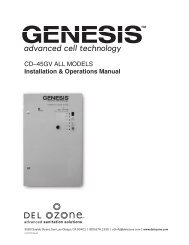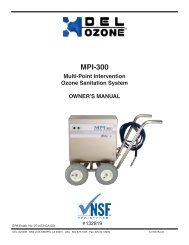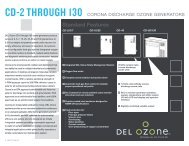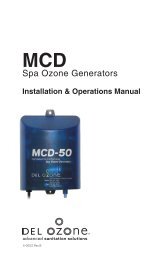Genesis CD-15G/25G - DEL Ozone
Genesis CD-15G/25G - DEL Ozone
Genesis CD-15G/25G - DEL Ozone
- No tags were found...
You also want an ePaper? Increase the reach of your titles
YUMPU automatically turns print PDFs into web optimized ePapers that Google loves.
<strong>Genesis</strong> <strong>CD</strong>–<strong>15G</strong> and <strong>CD</strong>–<strong>25G</strong> Installation & Operations ManualCarcinogenicity:Primary Entry:Target Organs:SECTION VI: HEALTH HAZARD DATA<strong>Ozone</strong> is not listed as a carcinogen by the NTP, IARC, or OSHA.InhalationRespiratory system, eyes, blood.Summary of Risks: There is no true threshold limit and so no exposure (regardless of how small) is theoretically without effectfrom ozone’s strong oxidative ability. <strong>Ozone</strong> passes straight to the smallest bronchioles and alveoli and is not absorbed bymucous membranes along the way. Initial small exposure may reduce cell sensitivity and/or increase mucous thicknessproducing a resistance to low ozone levels. Short exposure to 1-2 ppm concentrations causes headache as well as irritation tothe respiratory tract. but symptoms subside when exposure ends. High concentrations of ozone produce severe irritation of theeyes and respiratory tract. Exposure above the ACGIH/OSHA limits produce nausea, chest pain, coughing, fatigue, reducedvisual acuity, and pulmonary edema. Symptoms of edema from excessive exposure can be delayed one or more hours.Inhalation of >20 ppm for an hour or more (>50 ppm for 1/2 hour) can be fatal.Acute Effects:Chronic Effects:Acute damage from ozone appears to be mainly from its oxidizing effect on contact with tissue.Respiratory disease. Deleterious effects on lungs and acceleration of tumors have been reported.Medical Conditions Generally Aggravated by Long-Term Exposure:History of respiratory or heart disorders.First Aid: Remove from ozone containing air, get prompt medical help*, administer oxygen if necessary.Eye Contact - Gently lift eyelids and flush eyes continuously with flooding amounts of water for 15 minutes or until transported to amedical facility*.Inhalation - Remove exposed person to fresh air, support breathing, administer humidified oxygen as needed, get medical help*.Ingestion - Highly unlikely since ozone is a gas until -169° F,* GET MEDICAL ASSISTANCE = APPROPRIATE IN-PLANT, PARAMEDIC, or COMMUNITY. Get prompt medical assistance forfurther treatment, observation, and support after first aid.SECTION VII: PRECAUTIONS FOR SAFE HANDLING AND USESteps to be Taken in Case of Spill/Leak:1. Discontinue production2. Isolate and vent area3. Immediately notify personnel4. Deny entry5. Follow applicable OSHA regulationsDisposal: Provide ventilation to dilute and disperse small amounts of ozone (below OSHA PELs) to outside atmosphere. Followfederal, state, and local regulations.Handling/Storage Precautions:Respiratory Protection:Eye Protection:Skin Protection:Ventilation:Ensure proper personnel training and establish emergency procedures.SECTION VIII: CONTROL MEASURESHigh Level (>10 ppm) - Self Contained Breathing Apparatus: MISH/NIOSH approved.Low Level (0.3 - 10 ppm) - Canister Type (carbon) respirator may be used.Wear chemical safety goggles if necessary to work in high ozone (>10 ppm).Effects of ozone on skin are minimal to non-existent.Provide general and local exhaust ventilation to dilute & disperse small amounts of ozone into outside atmosphere.SECTION IX: SPECIAL PRECAUTIONS AND COMMENTSStorage Segregation: Prevent ozone from coming into direct physical contact with strong acids or bases or with strongoxidizing/reducing agents.Engineering Controls: Install ventilation systems capable of maintaining ozone to concentrations below the ACGIH/OSHAexposure limits (see sect. II). Install ambient ozone monitor(s) configured to shut down ozone equipment and turn high speedventilation on.4-0697_ Rev.B11



